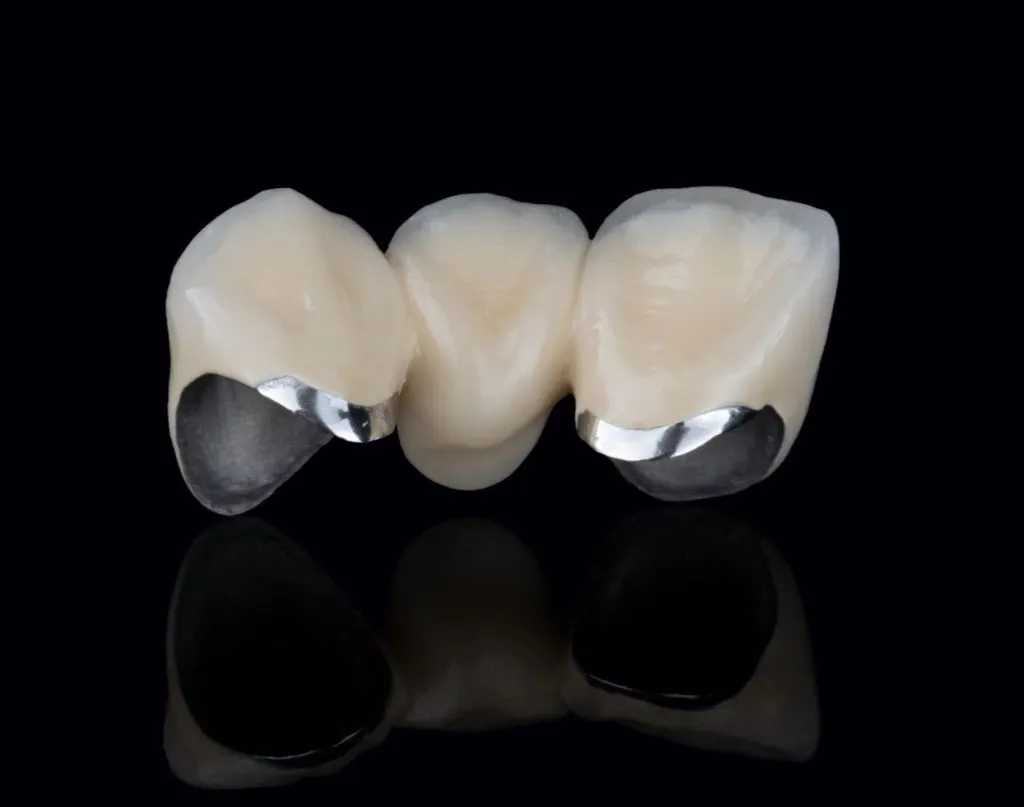Porcelain Fused To Metal Dental Crowns (PFM)
- Home
- Porcelain Fused To Metal Dental Crowns (PFM)
Porcelain Fused To Metal Dental Crowns (PFM): Everything You Need to Know
As we grow older, our teeth start showing signs of wear and tear. Factors such as poor oral hygiene, genetics, and lifestyle choices like smoking or excessive consumption of sugary foods can accelerate the process of tooth decay and erosion. When teeth become damaged or chipped, a dental crown can be used to restore their shape, size, and strength. Porcelain Fused to Metal Dental Crowns (PFM) is a popular type of dental crown that has been in use for several decades. In this article, we will discuss what PFM crowns are, how they are made, their pros and cons, procedure, cost, types, and their use cases in the dental industry.
What is Porcelain Fused To Metal Dental Crowns (PFM)?
Porcelain fused to metal (PFM) crowns is a type of dental crown that combines the strength of metal with the aesthetics of porcelain. The crown has a metal base, which is covered by a layer of porcelain to give it a natural tooth-like appearance. The metal base provides strength and durability, while the porcelain layer mimics the natural color and translucency of teeth. PFM crowns are also referred to as porcelain-metal crowns or metal-ceramic crowns.

How are Porcelain Fused To Metal Dental Crowns (PFM) made?
The process of making PFM crowns typically involves two steps. In the first step, the dentist prepares the damaged tooth by removing the damaged or decayed portion of the tooth. The remaining tooth structure is then shaped to receive the crown. The dentist will take an impression of the prepared tooth and the surrounding teeth and gums, which will be used to fabricate the crown.
In the second step, the dental laboratory creates the PFM crown based on the impression taken by the dentist. The metal base of the crown is fabricated using a dental alloy that is a mixture of metals such as gold, silver, or nickel-chromium. The metal base is shaped to fit the prepared tooth and is fused to a layer of porcelain to give it a natural tooth-like appearance. The porcelain layer is then shaped and polished to match the surrounding teeth, giving the crown a natural-looking finish.
Pros and Cons of Porcelain Fused To Metal Dental Crowns (PFM)
Like any dental procedure, PFM crowns have their pros and cons. Here are some of the advantages and disadvantages of PFM crowns:
Porcelain Fused To Metal Pros:
- PFM crowns are strong and durable, making them suitable for restoring teeth that undergo significant chewing and biting forces.
- They have a natural-looking appearance that mimics the translucency and color of natural teeth.
- PFM crowns can be customized to match the color and shape of surrounding teeth, making them an excellent choice for restoring front teeth.
- They are less expensive than all-porcelain or all-ceramic crowns.
Porcelain Fused To Metal Cons:
- PFM crowns may have a visible metal margin at the base of the crown, especially if the patient has receding gums or thin gum tissue.
- The metal base of the crown can sometimes show through the porcelain layer, giving the crown a dark or gray appearance.
- The metal base can cause thermal sensitivity, which may result in discomfort when consuming hot or cold foods and beverages.
- PFM crowns require more tooth preparation than all-porcelain or all-ceramic crowns, which can weaken the tooth structure.
Porcelain Fused To Metal Dental Crowns (PFM) Procedure
The PFM crown procedure typically involves two visits to the dentist’s office. During the first visit, the dentist will prepare the tooth by removing the damaged or decayed portion of the tooth and shaping it to receive the crown. The dentist will then take an impression of the prepared tooth and the surrounding teeth and gums, which will be sent to the dental laboratory for fabrication.
In the second visit, the dentist will check the fit of the PFM crown and make any necessary adjustments. The crown will then be permanently cemented onto the tooth using dental cement. The dentist will also provide instructions on how to care for the crown, which typically involves brushing and flossing regularly and avoiding hard or sticky foods that could damage the crown.
How much do Porcelain Fused To Metal Dental Crowns (PFM) cost?
The cost of PFM crowns can vary depending on several factors, including the location of the dental practice, the materials used to fabricate the crown, and the complexity of the procedure. On average, PFM crowns can cost between $800 to $1,500 per tooth. However, some dental insurance plans may cover a portion of the cost of the crown, so it is essential to check with your insurance provider to see what is covered.
How much do Porcelain Fused To Metal Dental Crowns (PFM) cost to make?
The cost of fabricating PFM crowns can also vary depending on the materials used and the complexity of the procedure. The cost of the dental alloy used to fabricate the metal base of the crown can range from $20 to $50 per gram, while the cost of the porcelain used to cover the metal can range from $50 to $200 per gram. The labor cost of the dental laboratory to fabricate the crown can also add to the overall cost. On average, the cost of fabricating a PFM crown can range from $100 to $400.
Different types of Porcelain Fused To Metal Dental Crowns (PFM)
There are several different types of PFM crowns, each with their unique characteristics and advantages. Some of the most common types of PFM crowns include:
High Noble Metal Crowns: These crowns are made using a high noble metal alloy, which typically contains at least 60% gold or platinum. High noble metal crowns are the most expensive type of PFM crown but are also the most biocompatible and long-lasting.
Noble Metal Crowns: These crowns are made using a noble metal alloy, which typically contains a combination of gold, silver, and other metals. Noble metal crowns are less expensive than high noble metal crowns but are still durable and biocompatible.
Base Metal Alloy Crowns: These crowns are made using a base metal alloy, which typically contains metals such as nickel-chromium or cobalt-chromium. Base metal alloy crowns are the least expensive type of PFM crown but are also less biocompatible and less durable than high noble or noble metal crowns.
Zirconia Crowns: Zirconia crowns are a newer type of PFM crown that uses a zirconia base instead of metal. Zirconia crowns are strong, durable, and have a natural-looking appearance. However, they are typically more expensive than traditional PFM crowns.
Use case for Porcelain Fused To Metal Dental Crowns (PFM) in the dental industry
PFM crowns have been a popular choice for dental restorations for several decades. They are strong, durable, and have a natural-looking appearance that makes them an excellent choice for restoring teeth in the front of the mouth. PFM crowns are also less expensive than all-porcelain or all-ceramic crowns, making them a more affordable option for patients.
PFM crowns are commonly used in the following situations:
- To restore severely damaged or decayed teeth that cannot be repaired with fillings or other restorative
options.
To cover dental implants and protect them from damage.
To protect and strengthen teeth that have undergone root canal treatment.
To improve the appearance of misshapen, discolored, or unevenly spaced teeth.
To replace old or worn-out dental restorations, such as crowns or bridges.
Pros and Cons of Porcelain Fused To Metal Dental Crowns (PFM).
Like any dental restoration, PFM crowns have both advantages and disadvantages. Understanding these pros and cons can help patients make an informed decision about whether PFM crowns are the right choice for their dental needs.
Pros of Porcelain Fused To Metal Dental Crowns (PFM)
Durability: PFM crowns are strong and durable, making them a long-lasting solution for dental restorations.
Natural-looking appearance: The porcelain covering of PFM crowns can be matched to the color of the patient’s natural teeth, creating a natural-looking appearance.
Affordability: PFM crowns are less expensive than all-porcelain or all-ceramic crowns, making them a more affordable option for patients.
Biocompatibility: The metal used in PFM crowns is biocompatible, meaning that it is safe to use in the body without causing adverse reactions.
Cons of Porcelain Fused To Metal Dental Crowns (PFM)
Metal visibility: The metal base of PFM crowns can be visible at the gum line, creating a dark line that can be visible when the patient smiles or speaks.
Wear on opposing teeth: The metal used in PFM crowns can be abrasive and cause wear on the opposing teeth.
Allergic reactions: Some patients may have allergic reactions to the metals used in PFM crowns.
Difficulty in detecting cavities: PFM crowns can make it more difficult to detect cavities underneath the crown.
Porcelain Fused To Metal Dental Crowns (PFM) are a popular dental restoration option that combines the strength of metal with the natural-looking appearance of porcelain. PFM crowns are strong, durable, and more affordable than all-porcelain or all-ceramic crowns, making them a popular choice for patients.
However, PFM crowns do have some disadvantages, including metal visibility, wear on opposing teeth, and difficulty in detecting cavities underneath the crown. It is essential for patients to discuss the pros and cons of PFM crowns with their dentist to determine whether they are the right choice for their dental needs.
Overall, PFM crowns remain a viable and effective option for dental restorations, providing patients with a durable and natural-looking solution to their dental needs.

